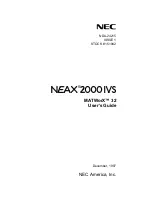
Chapter 11.
109
Steps to Get You Started
11.1. Upgrade or Install?
For information to help you determine whether to perform an upgrade or an installation refer to
Chapter 24, Upgrading Your Current System
.
11.2. Preparation for IBM eServer System p and System i
The IBM eServer System p and IBM eServer System i systems introduce many options for partitioning,
virtual or native devices, and consoles. Both versions of the system use the same kernel and have
many of the same options available, depending on the system configuration.
If you are using a non-partitioned System p system, you do not need any pre-installation setup. For
systems using the HVSI serial console, hook up your console to the T2 serial port.
If using a partitioned system, whether IBM System p or IBM System i the steps to create the partition
and start the installation are largely the same. You should create the partition at the HMC and assign
some CPU and memory resources, as well as SCSI and Ethernet resources, which can be either
virtual or native. The HMC create partition wizard steps you through the creation.
For more information on creating the partition, refer to IBM's Infocenter article on
Configuring Linux
logical partitions
available online at:
http://publib.boulder.ibm.com/infocenter/eserver/v1r3s/index.jsp?
topic=/iphbi/iphbikickoff.htm
If you are using virtual SCSI resources, rather than native SCSI, you must configure a 'link' to the
virtual SCSI serving partition, and then configure the virtual SCSI serving partition itself. You create a
'link' between the virtual SCSI client and server slots using the HMC. You can configure a virtual SCSI
server on either AIX or i5/OS, depending on which model and options you have.
For more information on using virtual devices, including IBM Redbooks and other online resources
see:
http://publib.boulder.ibm.com/infocenter/eserver/v1r3s/index.jsp?topic=/iphbi/iphbirelated.htm
Additional information on virtualization eServer i5 can be found in the IBM Redbook SG24-6388-01,
Implementing POWER Linux on IBM System i Platform
. This can be accessed at:
http://
www.redbooks.ibm.com/redpieces/abstracts/sg246388.html?Open
Once you have your system configured, you need to Activate from the HMC or power it on. Depending
on what type of install you are doing, you may need to configure SMS to correctly boot the system into
the installation program.
11.3. Do You Have Enough Disk Space?
Nearly every modern-day operating system (OS) uses
disk partitions
, and Red Hat Enterprise Linux is
no exception. When you install Red Hat Enterprise Linux, you may have to work with disk partitions. If
you have not worked with disk partitions before (or need a quick review of the basic concepts), refer to
Chapter 26, An Introduction to Disk Partitions
before proceeding.
The disk space used by Red Hat Enterprise Linux must be separate from the disk space used by other
OSes you may have installed on your system.
Before you start the installation process, you must
Содержание ENTERPRISE LINUX 5 - VIRTUAL SERVER ADMINISTRATION
Страница 12: ...xii ...
Страница 20: ......
Страница 30: ...12 ...
Страница 32: ...14 ...
Страница 82: ...64 ...
Страница 106: ...88 ...
Страница 122: ...104 ...
Страница 124: ...106 ...
Страница 126: ......
Страница 132: ...114 ...
Страница 168: ...150 ...
Страница 182: ...164 ...
Страница 192: ...174 ...
Страница 194: ......
Страница 236: ...218 ...
Страница 238: ...220 ...
Страница 270: ......
Страница 274: ...256 ...
Страница 278: ...260 ...
Страница 292: ...274 ...
Страница 294: ......
Страница 300: ...282 ...
Страница 304: ......
Страница 316: ...298 ...
Страница 357: ...Creating Partitions 339 Figure 32 7 Creating a Software RAID Device 4 Click OK to add the device to the list ...
Страница 370: ...352 ...
Страница 384: ...366 ...
Страница 385: ...Part VII Appendix ...
Страница 386: ......
















































